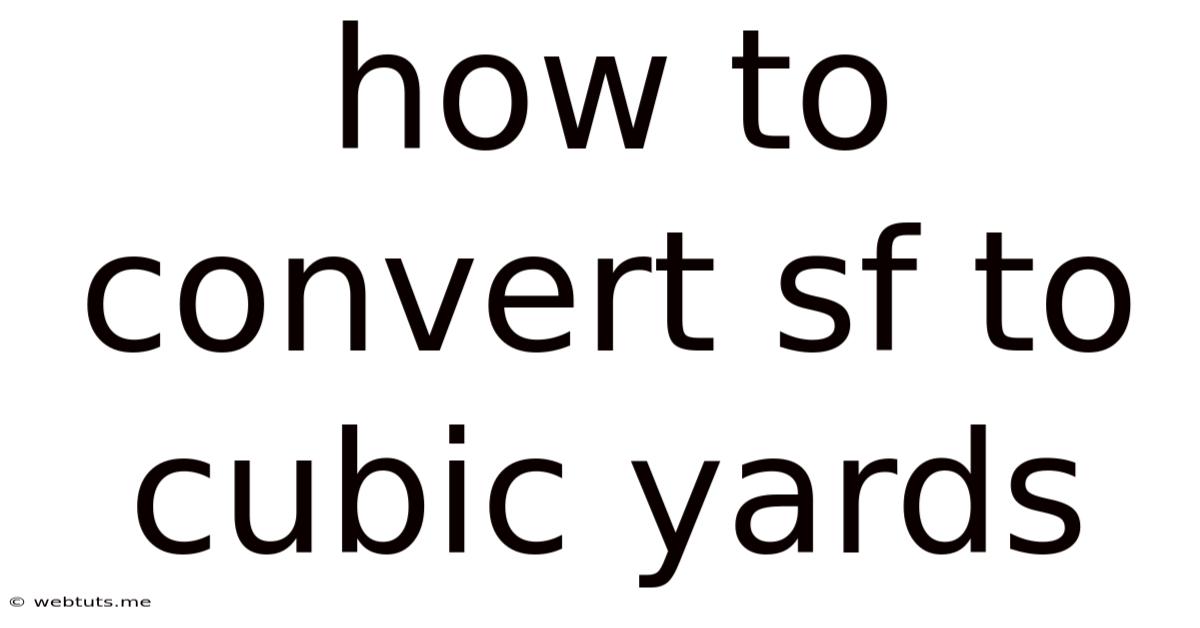How To Convert Sf To Cubic Yards
Webtuts
May 09, 2025 · 4 min read

Table of Contents
How to Convert Cubic Feet (SF) to Cubic Yards: A Comprehensive Guide
Converting cubic feet (sf) to cubic yards is a common task in various fields, from construction and landscaping to shipping and material estimation. Understanding this conversion is crucial for accurate calculations and efficient project planning. This comprehensive guide will walk you through the process, explain the underlying principles, and provide practical examples to solidify your understanding.
Understanding Cubic Measurements
Before diving into the conversion, let's clarify the units involved:
- Cubic Foot (cu ft or ft³): Represents the volume of a cube with sides measuring one foot each. It's a unit of volume commonly used in the United States.
- Cubic Yard (cu yd or yd³): Represents the volume of a cube with sides measuring one yard each (3 feet). It's also frequently used in construction and material estimations.
The key difference lies in the scale: a cubic yard is significantly larger than a cubic foot. This disparity necessitates a conversion factor to move between these units accurately.
The Conversion Factor: From Cubic Feet to Cubic Yards
The fundamental relationship between cubic feet and cubic yards stems from the relationship between feet and yards: 1 yard = 3 feet. Because volume is three-dimensional, this translates to:
1 cubic yard = 3 feet × 3 feet × 3 feet = 27 cubic feet
This is our crucial conversion factor. To convert cubic feet to cubic yards, we'll divide the number of cubic feet by 27.
The Formula: Converting Cubic Feet to Cubic Yards
The formula for converting cubic feet (ft³) to cubic yards (yd³) is remarkably simple:
Cubic Yards (yd³) = Cubic Feet (ft³) / 27
This formula remains consistent regardless of the context or application.
Practical Examples: Real-World Applications
Let's illustrate the conversion process with several real-world examples:
Example 1: Calculating the volume of a sandbox.
Imagine you're building a sandbox with dimensions of 4 feet long, 3 feet wide, and 1 foot deep.
-
Calculate the volume in cubic feet: Volume = Length × Width × Height = 4 ft × 3 ft × 1 ft = 12 ft³
-
Convert cubic feet to cubic yards: Cubic Yards = 12 ft³ / 27 = 0.44 yd³ (approximately)
Example 2: Estimating the amount of topsoil needed for a garden.
You need to fill a garden bed with topsoil. The garden bed measures 10 feet long, 5 feet wide, and 0.5 feet deep.
-
Calculate the volume in cubic feet: Volume = 10 ft × 5 ft × 0.5 ft = 25 ft³
-
Convert cubic feet to cubic yards: Cubic Yards = 25 ft³ / 27 = 0.93 yd³ (approximately)
Example 3: Determining the capacity of a storage container.
A storage container has internal dimensions of 8 feet long, 6 feet wide, and 4 feet high.
-
Calculate the volume in cubic feet: Volume = 8 ft × 6 ft × 4 ft = 192 ft³
-
Convert cubic feet to cubic yards: Cubic Yards = 192 ft³ / 27 = 7.11 yd³ (approximately)
Example 4: Handling Irregular Shapes.
For irregularly shaped volumes, you might need to break them down into smaller, manageable shapes (cubes, rectangular prisms) and calculate their volumes individually. Summing the individual volumes will give you the total volume in cubic feet, which you can then convert to cubic yards using the same formula. Approximation may be necessary for complex shapes.
Beyond the Basics: Advanced Considerations and Tips
While the basic formula is straightforward, certain situations may require additional considerations:
-
Loose vs. Compacted Materials: When dealing with materials like soil or gravel, the volume will change depending on how tightly it's packed. Loose material will occupy more space than compacted material. Always account for this variation in your calculations, especially when ordering materials. It's common practice to add a safety margin (e.g., 10-20%) to compensate for settling.
-
Waste and Overages: In construction and landscaping projects, you should always account for material waste and overages. This helps prevent costly delays and ensures you have enough material to complete the project.
-
Using a Calculator or Spreadsheet: For more complex calculations or large-scale projects, it's often more efficient to use a calculator or spreadsheet software. Many online conversion tools are also available.
Common Mistakes to Avoid
-
Forgetting the Conversion Factor: The most common mistake is forgetting that there are 27 cubic feet in a cubic yard. Double-check your calculations to ensure you're using the correct conversion factor.
-
Incorrect Unit Conversions: Ensure you're consistently using the same units throughout your calculations. Converting measurements from inches to feet or yards before calculating volume is crucial for accuracy.
-
Neglecting Material Characteristics: Ignoring the differences between loose and compacted materials can lead to inaccurate material estimations.
Conclusion
Converting cubic feet to cubic yards is an essential skill in many fields. By mastering the simple formula and understanding the underlying principles, you can efficiently and accurately calculate volumes, estimate material quantities, and plan projects effectively. Remember to always account for potential variables like material compaction, waste, and overages to ensure your project's success. Practice with various examples and scenarios to build confidence and proficiency in these crucial conversions.
Latest Posts
Latest Posts
-
What Is 16 Kg In Pounds
May 09, 2025
-
90 Days From May 24 2024
May 09, 2025
-
75 Days From April 15 2024
May 09, 2025
-
How Many Cups In A 5 Pound Bag Of Sugar
May 09, 2025
-
What Is 15 Mm In Standard
May 09, 2025
Related Post
Thank you for visiting our website which covers about How To Convert Sf To Cubic Yards . We hope the information provided has been useful to you. Feel free to contact us if you have any questions or need further assistance. See you next time and don't miss to bookmark.